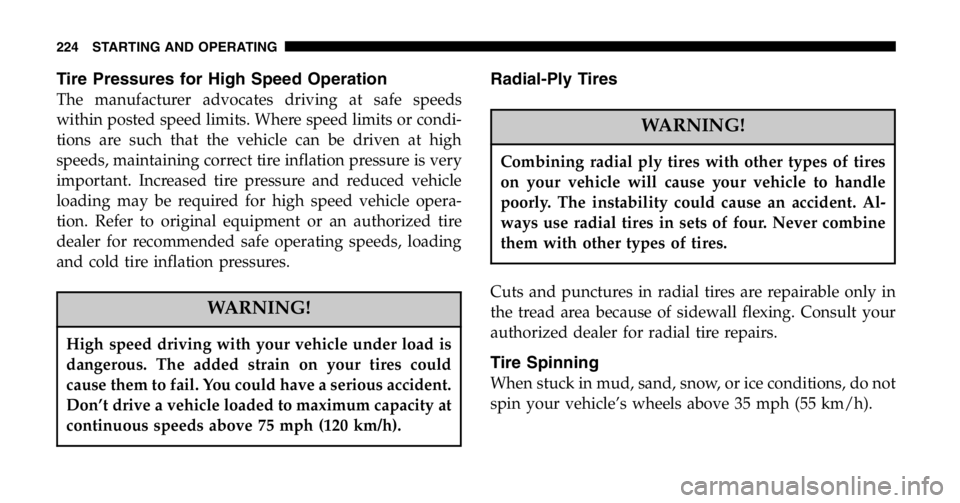lock JEEP WRANGLER 2006 Owners Manual
[x] Cancel search | Manufacturer: JEEP, Model Year: 2006, Model line: WRANGLER, Model: JEEP WRANGLER 2006Pages: 1472, PDF Size: 12.64 MB
Page 58 of 1472

9. Finish tightening the lug nuts. Push down on the
wrench while tightening for increased leverage. Alternate
nuts until each nut has been tightened twice. Correct
wheel nut tightness is 130 N·m (95 ft. lbs). If in doubt
about the correct tightness, have them checked with a
torque wrench by your authorized dealer or at a service
station.
10. Remove jack assembly and wheel blocks.
WARNING!
A loose tire or jack, thrown forward in a collision or
hard stop could endanger the occupants of the ve-
hicle. Always stow the jack parts and the spare tire in
the places provided.
To prevent personal injury or damage to clothing, do
not allow battery fluid to contact eyes, skin, or
fabrics. Do not lean over a battery when connecting
jumper cables or allow cable clamps to touch each
other. Keep open flames or sparks away from battery
vent holes. Always wear eye protection when work-
ing with batteries. Do not use a booster battery or
any other booster source that has a greater than
12–volt system, i.e. do not use a 24–volt power
source.
Page 83 of 1472

Cavity Fuse/Color Description
29 Relay ASD
30 Relay A/C Clutch
31 Relay Transmission
32 Relay Starter
33 Relay ABS
34 Open
35 Relay Fog Lamp
36 Relay Horn
37 Relay Fuel Pump
38 Relay HBL (Rear Window Defroster)
39 Relay Front Differential Locker (Ru- bicon) or High Speed Fan
(2.4L Engines)
40 Relay Rear Differential Locker (Ru- bicon) or Low Speed Fan
(2.4L Engines)
308 MAINTAINING YOUR VEHICLE
Page 169 of 1472

Always remove the key from the ignition, and lock
all doors when leaving the vehicle unattended.
Page 218 of 1472

If the hood is not fully latched, it could fly up when
the vehicle is moving and block your forward vision.
Be sure all hood latches are latched fully before
driving.
Hood Latch
UNDERSTANDING THE FEATURES OF YOUR VEHICLE 63
3
Page 224 of 1472

Tilting the steering column while the vehicle is
moving is dangerous. Without a stable steering col-
umn, you could lose control of the vehicle and have
an accident. Adjust the column only while the ve-
hicle is stopped. Be sure it is locked before driving.
3
Page 342 of 1472

Manual Transmission Shift Speeds in MPH (KM/H)
Engine Speeds 1 to 2 2 to 3 3 to 4 4 to 5 5 to 6
2.4L Accel. 14 (23) 24 (39) 34
(55) 46
(74) 57
(92)
Cruise 11 (18) 19 (31) 27
(43) 38
(61) 45
(72)
4.0L Accel. 15 (24) 24 (39) 34
(55) 47
(76) 56
(90)
Cruise 10 (16) 19 (31) 27
(43) 37
(60) 41
(66)
Clutch Interlocking Ignition System (Non —
Rubicon Models Only)
Manual transmission vehicles are equipped with a clutch
interlock safety feature. With this feature engaged, you
must depress the clutch pedal to allow cranking of the
engine. To temporarily bypass this safety feature while
off-road driving (4L range only), which will allow crank-
ing the engine without depressing the clutch, follow
these steps:
1. Locate the Power Distribution Center (PDC) in the
engine compartment. Refer to “Fuse Panel” in Section 7
of this manual. (See page 305 for more information.)
2. Put a 10 Amp fuse in the PDC cavity (#28) marked as
Clutch Override.
NOTE: A fuse is provided in fuseblock cavity (f19 or
f20) marked as Spare.
STARTING AND OPERATING 187
5
Page 344 of 1472

It is dangerous to shift the selector lever out of “P” or
“N” if the engine speed is higher than idle speed. If
your foot is not firmly on the brake pedal, the
vehicle could accelerate quickly forward or in re-
verse. You could lose control of the vehicle and hit
someone or something. Only shift into gear when
the engine is idling normally and when your right
foot is firmly on the brake pedal.
Brake Transmission Shift Interlock System
This vehicle is equipped with a brake transmission shift
interlock system (BTSI) that holds the gearshift lever in
the P (Park) position when the ignition switch is in the
OFF position. To move the gear selector lever out of the
P (Park) position, the ignition switch must be turned to
the ON position, the brake pedal and the button on the
front of the shifter handle must be depressed.
Gear Ranges
P (Park)
Supplements the parking brake by locking the transmis-
sion. The engine can be started in this range. Never use P
(Park) while the vehicle is in motion. Apply the parking
brake when leaving the vehicle in this range. Always
apply the parking brake first, and then place the selector
in P (Park) position.
STARTING AND OPERATING 189
5
Page 345 of 1472

WARNING!
Unintended movement of a vehicle could injure
those in and near the vehicle. As with all vehicles,
you should never exit a vehicle while the engine is
running. Before exiting a vehicle, you should always
shift the vehicle into P (Park), remove the key from
the ignition, and apply the parking brake. Once the
key is removed from the ignition, the transmission
shift lever is locked in the P (Park) position, securing
the vehicle against unwanted movement. Further-
more, you should never leave children unattended
inside a vehicle.
Before moving the shift lever out of P (Park), you
must turn the ignition from LOCK to ON so the
steering wheel and shift lever are released. Other-
wise, damage to the steering column or shifter could
result.
Page 361 of 1472

The Anti-Lock Brake System pump motor runs during
the self-test and during an ABS stop to provide the
regulated hydraulic pressure. The motor pump makes a
low humming noise during operation, this is normal.
During off-road use, loss of traction can temporarily
defeat the system and cause the warning light to illumi-
nate. Turn the ignition OFF and ON again to restore
Anti-Lock Brake System function.
WARNING!
Pumping of the Anti-Lock Brakes will diminish
their effectiveness and may lead to an accident.
Pumping makes the stopping distance longer. Just
press firmly on your brake pedal when you need to
slow down or stop.
WARNING!
Page 362 of 1472

The Anti-Lock Brake System is subject to possible
detrimental effects of electronic interference caused
by improperly installed aftermarket radios or tele-
phones.
NOTE: During severe braking conditions, a pulsing
sensation may occur and a clicking noise will be heard.
This is normal, indicating that the Anti-Lock Brake
System is functioning.
POWER STEERING
The standard power steering system will give you good
vehicle response and increased ease of maneuverability
in tight spaces. The system will provide mechanical
steering capability if power assist is lost. If for some reason, the power assist is interrupted, it will
still be possible to steer your vehicle. Under these condi-
tions you will observe a substantial increase in steering
effort, especially at very low vehicle speeds and during
parking maneuvers.
NOTE:
Increased noise levels at the end of the steering
wheel travel are considered normal and does not indicate
that there is a problem with the power steering system.
Upon initial start-up in cold weather, the power steering
pump may make noise for a short period of time. This is
due to the cold, thick fluid in the steering system. This
noise should be considered normal, and does not in any
way damage the steering system.
STARTING AND OPERATING 207
5